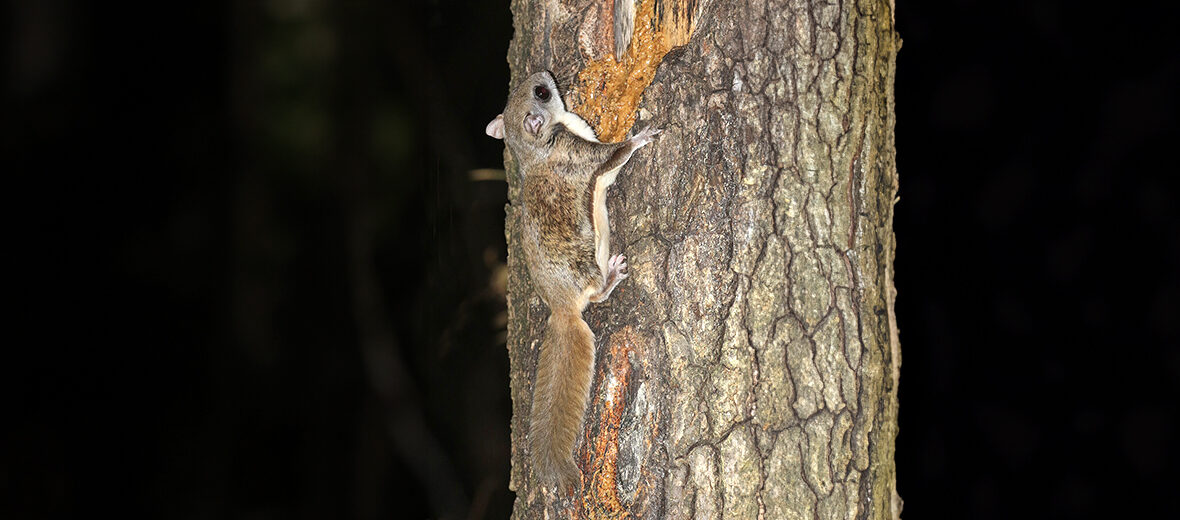
The southern flying squirrel, aka assapan, is just 1 of 3 flying squirrel species found in North America. They are native to southeastern Canada, eastern United States, the high country of Mexico, and Central America. While these critters face the threat of habitat loss and destruction at the hands of deforestation, they are abundant with a stable population and thus listed as Least Concern by the IUCN.
First the Stats…
Scientific name: Glaucomys volans
Weight: Up to 3.17 ounces
Length: Up to 10.2 inches, plus up to a 4.7 inch tail
Lifespan: Up to 10 years
Now on to the Facts!
1.) While they are called “flying squirrels” they don’t actually fly, but rather glide via their patagium (furry membrane that stretches from their forelegs to their backlegs.
2.) These flying squirrels are nocturnal (active at night).
3.) Snakes, owls, hawks, raccoons, cats, and dogs all prey on these squirrels.
4.) These squirrels act as a host to the Rickettsia prowazekii bacteria and transmission to humans is presumed to happen via aerosolized feces (poop) of the fleas and lice associated with these squirrels.
5.) It is hypothesized that they use triangulation to judge the distance of the landing area as they typically lean out and pivot from side to side right before jumping.
But wait, there’s more on the southern flying squirrel!
6.) Right before reaching a tree, they raise their flattened tails which abruptly alters their trajectory upwards, and points all of their limbs forward to create a parachute effect with the membrane in order to reduce the shock of impact.
7.) Females produce up to 2 litters per year.
Did you know…?
Unfortunately, exposure to some populations of southern flying squirrels has resulted in cases of epidemic typhus (typhus fever) in humans. Typhus spread by flying squirrels is known as “sylvatic typhus”. The Centers for Disease Control and Prevention has documented a total of 39 cases in the U.S. from 1976 – 2001.
8.) The female undergoes up to a 40-day gestation (pregnancy) that yields up to 7 pups.
9.) The pup’s ears open at up to 7 days, their fur grows in at up to 7 days, and their eyes open in up to 30 days.
10.) Pups are weaned in up to 65 days, and are fully independent in up to 120 days.
But wait, there’s still more on the southern flying squirrel!
11.) They prefer to dwell in habitats with an abundance of deciduous forests, mixed forests, large hickory trees, beech trees, maple, poplar, and oak trees.
12.) Southern flying squirrels are gregarious and are sometimes seen gliding in large groups. They also conglomerate together in dens when entering into torpor (a sleep-like state) during the colder winter months.
Did you know…?
These squirrels have been included in sports and popular culture as the Richmond Flying Squirrels get their name, logo, and mascot from these critters. Also, Emolga, an Electric/Flying type Pokémon hails from these critters, and finally the famous flying squirrel Rocket J. “Rocky” Squirrel was created from the likeness of these squirrels.
13.) Even though they enter into torpor, they don’t hibernate. It has been surmised that squirrels who aggregate can save up to 30% more energy during the colder months.
14.) It was discovered that communal nesting box temperatures could reach up to 100ºF, which could prove detrimental to these critters.
15.) They eat nuts, seeds, fruit, bark, buds, sap, suet, bird eggs, mice, shrews, insects, and even carrion (dead animals).
Now a Short Southern Flying Squirrel Video!
Be sure to share & comment below! Also, check out the Critter Science YouTube channel. Videos added regularly!
Want to suggest a critter for me to write about? Let me know here.
Some source material acquired from: Wikipedia & IUCN
Photo credit: Judy Gallagher




